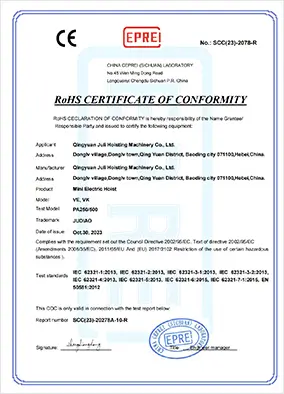


The Importance of Fall Protection Suppliers in Ensuring Workplace Safety
In various industries, the safety of workers is paramount. One of the most critical aspects of workplace safety involves fall protection. Falls are among the leading causes of serious injuries and fatalities in the workplace, particularly in construction, manufacturing, and warehousing. This is where specialized fall protection suppliers come into play, providing essential equipment and expertise to minimize these risks.
Understanding Fall Protection
Fall protection refers to a system designed to prevent workers from falling from heights or to arrest a fall before the worker reaches the lower level. This equipment can include harnesses, lanyards, lifelines, guardrails, and aerial lifts. The Occupational Safety and Health Administration (OSHA) has established specific regulations surrounding fall protection, necessitating that employers provide adequate safety measures whenever employees are working at heights of six feet or more in the construction industry, or four feet in general industry operations.
The Role of Fall Protection Suppliers
Fall protection suppliers play a critical role in ensuring that safety measures are effective and compliant with safety regulations. They offer a wide range of products tailored to various work environments, ensuring that businesses can find the appropriate solutions for their specific needs. A reputable fall protection supplier not only provides equipment but also offers training, certifications, and ongoing support to guarantee that employees know how to use the systems correctly and safely.
Quality and Compliance
When selecting a fall protection supplier, it’s crucial to consider the quality of the products offered
. High-quality equipment should meet or exceed industry standards and be tested for durability and performance. Suppliers that comply with OSHA regulations and ANSI (American National Standards Institute) standards are preferable, as they ensure that the equipment is both safe and reliable. Additionally, reputable suppliers should provide documentation that verifies the safety standards to which their products adhere.
Training and Support
Beyond providing equipment, fall protection suppliers often offer training programs for employees. This training is vital for ensuring that workers know how to use fall protection systems effectively. Understanding how to select the right equipment for a specific job and how to wear and use it properly can dramatically reduce the risk of falls. Moreover, suppliers may offer hazard assessments and consulting to help businesses identify potential fall risks and develop comprehensive safety plans.
Innovation and Technology
The fall protection industry continually evolves, with innovations in technology leading to more efficient and effective safety solutions. For instance, advancements in lightweight, durable materials lead to harnesses and lanyards that are easier to wear and move in, significantly enhancing worker comfort without sacrificing safety. Suppliers who stay abreast of these innovations can provide the best products available, helping companies maintain a safe working environment while optimizing productivity.
Building Strong Partnerships
Establishing a strong relationship with a fall protection supplier can be invaluable. A reliable supplier will understand the unique challenges of your specific industry and can offer tailored solutions that meet your organization’s needs. This partnership can lead to ongoing improvements in workplace safety and compliance, ultimately contributing to a safer, more efficient working environment.
Conclusion
In summary, fall protection suppliers are essential partners in the pursuit of workplace safety. By providing high-quality equipment, comprehensive training, and innovative solutions, they help organizations mitigate the risks of falls and create safer environments for workers. Investing in a reliable fall protection supplier is not only a regulatory necessity but also a commitment to the well-being of every employee. As industries continue to evolve, the importance of robust fall protection strategies will remain a crucial factor in workplace safety.



